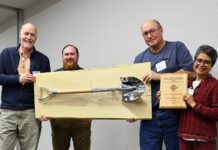PITTSBURGH, Pa. — Look for the number of wells being drilled in the Utica and Marcellus shale to fall. At the same time, look for production and efficiency from wells to grow.
The concise and common point of Hart Energy’s 2014 Marcellus Utica Midstream conference June 4 was that it takes time, technology and the right completion design to get the most out of the Utica and Marcellus shale wells.
Growing efficiency
A roundtable of experts discussed how the plays are changing and how technology is playing a part in its production.
D. Randall Wright, president of Wright and Company, said companies continue to evaluate the shale reserves as the wells are drilled.
Wright cautioned that not all areas of the Utica or Marcellus shale are economical for drilling. Wright said it is imperative the drillers connect to a quality reservoir, so they’re constantly analyzing the geology of the shale play.
Learning curve
Wright said there is a new learning curve, as more wells are drilled. The first generation of wells in the Marcellus shale did well, but the second generation is doing even better and he expects the same to happen in the Utica shale.
For example, in the second generation of wells, longer laterals are being developed. As drilling techniques have developed, the laterals have increased to between 4,000-7,000 feet.
Experience and technology has also developed greater efficiency of the spacing on well sites. When well development began, the spacing between holes was typically around 1,000 feet. They are now usually 500 feet in the north and 700 feet in the south.
Drillers outlook
Jeff Ventura, president of Range Resources, told the crowd that Range is getting ready to celebrate the 10th anniversary of their discovery in the Marcellus shale and he feels that efficiency has gotten better as drillers learn about the play.
He said what was learned from the first wells helped to develop the wells of today.
Tim Dugan, Consol Energy, chief operating officer, described the oil window in the Utica shale as being a challenge.
He said finding the Utica sweet spot will be a significant part of the growth in the Utica.
“As an industry, we are still looking for the key. It’s going to take time and testing,” said Dugan.
Stuart Maier, vice president for the geosciences at Gulfport Energy, said the company is working to improve its fracking design in order to improve its production rates.
They are also trying to define what works best as far as well spacing, lateral length and lateral orientation to get the most out of a well.
West Virginia
Michael Warren, senior vice president for Hart Energy Research and Consulting, said when the drilling started in West Virginia in 2005, the play was considered to include southern counties. Now the play has moved to the Northern Panhandle area between Ohio and Pennsylvania.
The panel members also noted how horizontal drilling is growing and vertical drilling, which was popular in Greene and Washington counties in Pennsylvania, is disappearing. That’s because better returns are being discovered using horizontal drilling.
Warren said one thing he is sure of, is that it will take years before Utica shale drilling in Pennsylvania takes off. Warren said more technology and testing is needed due to differences in technology and topography.
The group acknowledged that drilling for the Utica is being done, but it is focused in Beaver, Lawrence and Mercer counties.
Samuel Gorgen, operations research analyst, U.S. Energy Information Administration, said the rig count has stabilized around 100 in the Marcellus shale, but analysis shows individual production on each rig will increase due to what is now known about the play.
Marcellus play
Another conference panel discussed the efficiencies gained in the Marcellus shale.
Panel members included Robert Fulks, of Weatherford; Jonathan Floyd, drilling operations manager for Anadarko Petroleum Corporation; Iain McIntosh, of Baker Hughes and Casey McDonough.
The panelists agreed the more information that is gained from wells, the more drillers can anticipate what’s there and better prepare each site. The members agreed it is vital for drillers to have access to sonic logs and drillings reports before the well process begins.
Fracking process
Floyd said to get the most out of the Marcellus and Utica shale wells, both air and fluids have to be used to in the fracking process, not just air.
However, one challenge in the fracking process this spring has been getting enough sand projects.
McIntosh explained it is not as shortage of sand or ceramics, which are sometimes used in the fracking process. The problem has been logistics and getting the supplies on site.
The amount of sand used is related to how many fracturing stages the job needs and the length of the laterals used in the drilling process. Rice Energy, for example, used 28 million pounds of sand for fracking the “Big Foot” well in Belmont County.
The group said railroad and barge deliveries haven’t been able to keep up due to the number of construction projects also needing the sand and other construction materials.
Some of the drilling players gave updates on where they stand at the conference. To check out what they had to say, click here.










